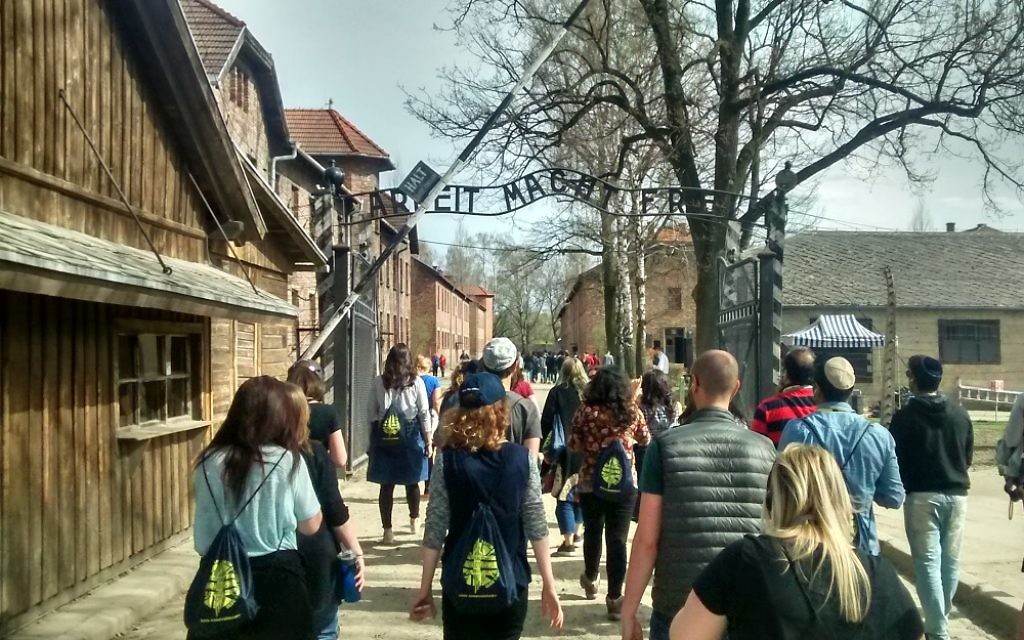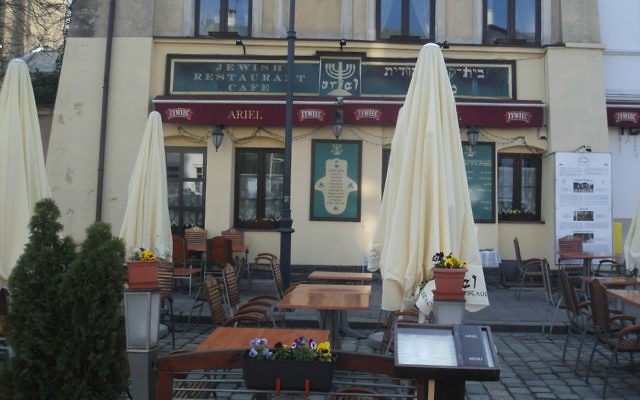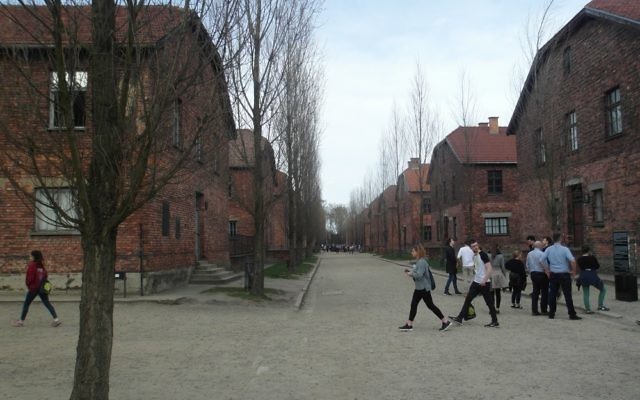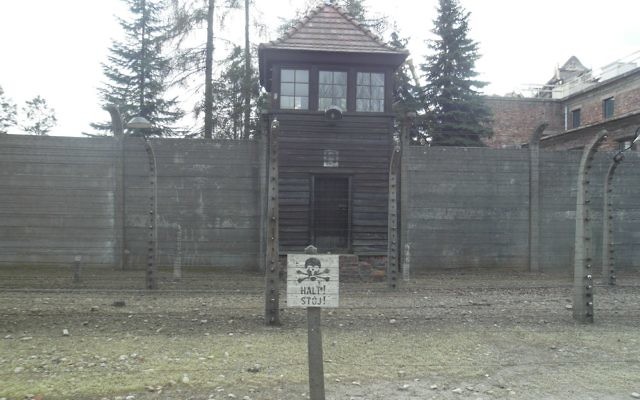March of the Living diary – Part III: Auschwitz Birkenau
Jewish News’ Andrew Sherwood has joined the UK Delegation in Poland is documenting his trip

Jewish News’ Andrew Sherwood is among nearly 300 Brits who have travelled to Poland for this year’s March of the Living trip.
The five-day journey culminates in a 1.5 mile march from Auschwitz I to Birkenau – with nearly 12,000 people participating from all around the world – to mark Yom Hashoah, Israel’s Holocaust Memorial Day.
Read Andrew’s reflections, as he learns about the history of Poland’s Jews, and prepares himself for the March at the Nazis’ most notorious death camp.
Get The Jewish News Daily Edition by email and never miss our top stories Free Sign Up
Day Four:
Wednesday was about visiting Auschwitz Birkenau, with the best part of six hours spent walking around the site.
Prior to that, and seeing that the last three days of the trip were in Krakow, we began with a visit to a square in the city, which – and as was becoming a pleasant theme for the start of our days – a place which had and was now celebrating its Jewish history.
While we just walked past the JCC of Krakow, a fascinating titbit – at least I thought it was – were the origins of it, which ultimately lie with Prince Charles, who having met Holocaust Survivors on a visit, asked what he could do to help. The rest as they say, is history.
The area also houses three Synagogues, two of which we visited, including a work of architectural art in The Tempel Synagogue. In fact the locals were so fond of the Jews that they still hold an annual Jewish Klezmer-ish festival there, attracting hundreds of people, both Jewish and non-Jewish. The streets are lined (at least one side is) by ‘Jewish’ shops, although anyone who keeps Kashruit should know the restaurant isn’t strictly kosher – quite literally!

Two hours later on the coach, and we reached Auschwitz Birkenau. We spent the morning at Auschwitz II–Birkenau, before spending the afternoon at the original site, Auschwitz I. In our preparation session for the trip the evening before, many things were discussed. What our expectations were going there, what we thought we’d take from visiting it, how we expected to feel.
Having always ‘wanted’ to visit it, I was expecting emotion, perhaps anger, and a sense of closure. Not in the sense of drawing a line under it having visited it, but in terms of having learnt about it in books and watched documentaries on television, I would now be experiencing the site in person, and therefore something in my mind would be complete.
Listen to the Jewish Views Podcast:
Entering the site, the railway tracks certainly hit a nerve. As did the watchtower as we continued our walk, and then the sight of a cattle car, one that had not been renovated, not retouched, but stood there as it had 70-odd years ago. While the previous visits to Majdanek and Belzec had stirred emotions, left me motionless in thought and struggling to comprehend how such barbaric and sick acts could have been carried out by one human on another, this was what you – at least I – more commonly associate with Concentration Camps.

And then there was almost indifference. Not that what I saw for the remaining two-and-a-half hours was easy to view, it’s just almost the shock value wasn’t registering. Perhaps the past three days had desensitised me. There were still the lump-in-the-throat moments, the feeling of sheer disdain, disbelief and emptiness, looking at the exact spot prisoners, had been stripped and then burnt in a makeshift, shallow grave, with officers then inspecting the results. All this illustrated by three pictures depicting the above sentence – hard to comprehend. Seemingly looking inside the barracks, just as we had 48 hours earlier. Perhaps, and for me even more disturbingly, it was not such a shock anymore.
That though changed for me at Auschwitz I. Walking under the Arbeit macht frei gate really did all of a sudden hit home exactly where I was. The numbers – people killed – which I’d been told about in the morning, the frequency of killings all suddenly began to become all too real, and then we went into the barracks. Knowing what I would be seeing was one thing, seeing them in person was another. The mass of human hair, thousands upon thousands of stacked shoes, clothes, prosthetic legs, walking into rooms where thousands of people had been brutally tortured and killed. Now the emotion was there. I felt proud walking around the blocks, able to wear a kippah, wearing my Star of David around my neck. It was my own way of sticking two fingers up at Hitler, not much in the grand scheme of things, but it was for me and made me feel better for myself.

The evening was spent at the Galicia Hotel which hosted the March of the Living UK ceremony. Sir Eric Pickles and the parliamentary chair of Labour Friends of Israel, Joan Ryan MP, spoke to rapturous applause, followed by March of the Living UK staff. The seven Holocaust Survivors who were on each of the buses lit a candle with a younger relative, before a singing of The Hatikvah ended the event. A further processing session took place to round the evening off, allowing people to talk about their day, their emotions, feelings. A mixture and variety were apparent, but there wasn’t one person in the group who hadn’t been significantly moved by the day.
You can read PART I of Andrew’s March of the Living diary here
You can read PART II of Andrew’s March of the Living diary here

Thank you for helping to make Jewish News the leading source of news and opinion for the UK Jewish community. Today we're asking for your invaluable help to continue putting our community first in everything we do.
For as little as £5 a month you can help sustain the vital work we do in celebrating and standing up for Jewish life in Britain.
Jewish News holds our community together and keeps us connected. Like a synagogue, it’s where people turn to feel part of something bigger. It also proudly shows the rest of Britain the vibrancy and rich culture of modern Jewish life.
You can make a quick and easy one-off or monthly contribution of £5, £10, £20 or any other sum you’re comfortable with.
100% of your donation will help us continue celebrating our community, in all its dynamic diversity...
Engaging
Being a community platform means so much more than producing a newspaper and website. One of our proudest roles is media partnering with our invaluable charities to amplify the outstanding work they do to help us all.
Celebrating
There’s no shortage of oys in the world but Jewish News takes every opportunity to celebrate the joys too, through projects like Night of Heroes, 40 Under 40 and other compelling countdowns that make the community kvell with pride.
Pioneering
In the first collaboration between media outlets from different faiths, Jewish News worked with British Muslim TV and Church Times to produce a list of young activists leading the way on interfaith understanding.
Campaigning
Royal Mail issued a stamp honouring Holocaust hero Sir Nicholas Winton after a Jewish News campaign attracted more than 100,000 backers. Jewish Newsalso produces special editions of the paper highlighting pressing issues including mental health and Holocaust remembrance.
Easy access
In an age when news is readily accessible, Jewish News provides high-quality content free online and offline, removing any financial barriers to connecting people.
Voice of our community to wider society
The Jewish News team regularly appears on TV, radio and on the pages of the national press to comment on stories about the Jewish community. Easy access to the paper on the streets of London also means Jewish News provides an invaluable window into the community for the country at large.
We hope you agree all this is worth preserving.
-
By Laurent Vaughan - Senior Associate (Bishop & Sewell Solicitors)
-
By Laurent Vaughan - Senior Associate (Bishop & Sewell Solicitors)
-
By Laurent Vaughan - Senior Associate (Bishop & Sewell Solicitors)
-
By Laurent Vaughan - Senior Associate (Bishop & Sewell Solicitors)





















